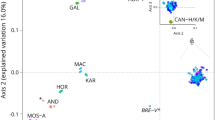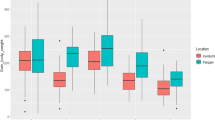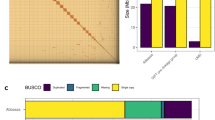Abstract
We investigated the electrophoretic polymorphism at 30 protein loci in 27 wild and cultured populations of two tilapia species, Tilapia zillii and Oreochromis niloticus. Single and joint segregations were analysed at 12 polymorphic loci in full-sib families. All the loci showed single segregation in agreement with the Mendelian expectations, and two nonrandom joint segregations were found. In total, 26 loci were polymorphic and 12 were diagnostic between the two species. A pronounced differentiation was observed between the Ivory Coast and Nilo-Sudanian T. zillii populations (average Nei's standard genetic distance = 0.13). Within the Nilo-Sudanian region, the level of variation observed in O. niloticus and T. zillii was rather low when compared with other freshwater species analysed at similar macrogeographical scales. The same pattern of geographical differentiation was found between the west and east African populations in both species suggesting that this structuring mainly reflected the same palaeo-geographical events. Most of the geographical variation observed in the Nile tilapia populations analysed here was present in the cultured stocks. In contrast to fish-farmed stocks analysed in other countries, those from the Ivory Coast and Niger displayed neither evidence of loss of genetic diversity nor any trace of introgression with other cultured tilapia species, indicating that these stocks have been properly managed.
Similar content being viewed by others
Article PDF
References
Agnèse, J F. 1989. Différentiation Génétique de Plusieurs Espèces de Siluriformes Ouest-Africains Ayant un Intérêt pour la Pêche et l'Aquaculture Ph.D. thesis, Université des Sciences et Techniques du Languedoc, Montpellier, France.
Basiao, Z U, and Taniguchi, N. 1983. An investigation of enzyme and other protein polymorphism in Japanese stocks of the tilapias Oreochromis niloticus and Tilapia zillii. Aquaculture, 38, 335–345.
Beadle, L G. 1981. The Inland Waters of Tropical Africa. An Introduction to Tropical Limnology, 2nd edn. Langman Inc., New York.
Brummett, R E, Halstrom, M L, Dunham, R A, and Smitherman, R O. 1988. Development of biochemical dichotomous keys for identification of American populations of Oreochromis aureus, O. mossambicus, O. niloticus, O. urolepis hornorum and Red tilapia. In: Pullin, R. S. V., Bhukasawan, T., Tonguthai, K. and Maclean, J. L. (eds) Second International Symposium on Tilapias in Aquaculture. ICLARM Conference Proceedings, 15, 135–141.
Cavalli-Sforza, L L, and Edwards, A W F. 1967. Phylogenetic analysis: models and estimation procedure. Evolution, 21, 550–570.
Daget, J, and Iltis, A. 1965. Poissons de Côte d'Ivoire (d'eaux douces et saumâtres). Mém Inst Fr Afr Noire, 74, 1–380.
Daget, J, and Moreau, J. 1981. Hybridation introgressive entre deux espèces de Sarotherodon (Pisces, Cichlidae) dans un lac de Madagascar. Bull Mus natl hist nat, Sect A Zool biol écol anim 2, 689–703.
Eknath, A E, Tayamen, M M, Palada-De Vera, M S, Danting, J C, Reyes, R A, Dionisio, E E. 1993. Genetic improvement of farmed tilapias: the growth performance of eight strains of Oreochromis niloticus tested in different farm environments. Aquaculture, 111, 171–188.
Felsenstein, J. 1993. PHYLIP (Phytogeny Inference Package), version 3.5c, University of Washington, Seattle.
Fitch, W M, and Margoliash, E. 1967. Construction of phylogenetic trees. Science, 155, 279–284.
Gorman, G C, Kim, Y J, and Rubinoff, R. 1976. Genetic relationships of three species of Bathygobius from the Atlantic and Pacific sides of Panama. Copeia, 2, 361–364.
Grove, A T. 1985. The physical evolution of the river basins. In: Grove A. T. (ed) The Niger and its Neighbours Environmental History and Hydrobiology, Human Use and Health Hazard of the Major West African Rivers, pp. 21–60. A. A. Balkena Publishers, Netherlands.
Gyllensten, U D. 1985. The genetic structure of fish: differences in the intraspecific distribution of biochemical genetic variation between marine, anadromous and freshwater species. J Fish Biol, 26, 691–699.
Howes, G J, and Teugels, G G. 1989. New bariliin cyprinid fishes from West Africa, with a consideration of their biogeography. J Nat Hist, 23, 873–902.
Jalabert, B, Kammacher, P, and Lessent, P. 1971. D´eterminisme du sexe chez les hybrides entre Tilapia macrochir et Tilapia nilotica. Etude de la sex-ratio dans les recroisements des hybrides de première génération par les espèces parentes. Ann Biol Anim Biochim Biophys, 11, 155–165.
Lazard, J. 1990. Transfert de poissons et développement de la production piscicole. Rev Hydrobiol Trop, 23, 251–265.
Lévêque, C, and Paugy, D. 1984. Guide des Poissons d'Eau Douce de la Zone du Programme de Lutte Centre l'Onchocerchose en Afrique de l'Ouest. Convention ORSTOM-OMS, Orstom Paris.
Lévêque, C, Dejoux, C, and Iltis, A. 1983. Limnologie du fleuve Bandama, Côte d'lvoire. Hydrobiologia, 100, 113–141.
Macaranas, J M. 1991. A Practical Laboratory Guide to the Techniques and Methodology of Electrophoresis and its Application to Fisheries Management. Fisheries Technology Manual no. 11. Philippine Council for Aquatic and Marine Research and Development, Les Baños, Laguna, Philippines.
Macaranas, J M, Taniguchi, N, Pante, J R, Capili, J B, and Pullin, R S V. 1986. Electrophoretic evidence for extensive hybrid gene introgression into commercial Oreochromis niloticus (L.) stocks in the Philippines. Aquacult Fish Manag, 17, 249–258.
Macaranas, J M, Agustin, L Q, Ablan, C A, Pante, J R, Eknath, A A, and Pullin, R S V. 1995. Genetic improvement of farmed tilapias: biochemical characterization of strain differences in Nile tilapia. Aquacult Int, 3, 43–54.
McAndrew, B J, and Majumdar, K C. 1983. Tilapia stock identification using electrophoretic markers. Aquaculture, 30, 249–261.
McAndrew, B J, and Majumdar, K C. 1984. Evolutionary relationships within three tilapiine genera (Pisces: Cichlidae). Zool J Linn Soc, 80, 421–435.
Morizot, D C, Slaugenhaupt, S A, Kallman, K D, and Chakravarti, A. 1991. Genetic linkage map of fishes of the genus Xiphophorus (Teleostei: Poecilidae). Genetics, 127, 399–410.
Nei, M. 1987. Molecular Evolutionary Genetics, Columbia University Press, New York.
Pouyaud, L. 1994. Génétique des Populations de Tilapias d'Intérêt Aquacole en Afrique de l'Ouest. Relations Phylogénétiques et Structurations Populationnelles. Ph.D. Thesis, Université des Sciences et Techniques, Montpellier. France.
Pouyaud, L, and Agnèse, J F. 1995. Differentiation génétique de plusieurs populations de Sarotherodon melanotheron et Tilapia guineensis de Côte d'lvoire et du Sénégal. In: Pullin, R. S. V., Lazard, J., Legendre, M., Amon Kothias, J. B. and Pauly, D. (eds), Third International Symposium on Tilapias in Aquaculture ICLARM Conference Proceedings, 41 (in press).
Pullin, R S V, and Capili, J B. 1988. Genetic improvement of tilapias: problems and prospects. In: Pullin, R. S. V., Bhukasawan, T., Tonguthai, K. and Maclean, J. L. (eds) Second International Symposium on Tilapias in Aquaculture ICLARM Conference Proceedings, 15, 259–266.
Raymond, M, and Rousset, F. 1995. GENEPOP (Version 1.2): Population genetics software for exact tests and ecumenicism. J Hered, 86, 248–249.
Rice, W R. 1989. Analyzing tables of statistical tests. Evolution, 43, 223–225.
Roberts, T R. 1975. Geographical distribution of African freshwater fishes. Zool J Linn Soc, 57, 249–319.
Rognon, X. 1993. Diversité Génétique et Relations Phylogénétiques chez les Tilapias (Pisces: Cichlidae) -Comparaison des Données du Polymorphisme Enzymatique et Mitochondrial. Ph.D. Thesis, Université de Paris-Sud, Orsay, France.
Rognon, X, and Guyomard, R. 1995. Etude de la variation génétique dans les populations domestiques d'Oreochromis sp. In: Pullin, R. S. V., Lazard, J., Legendre, M., Amon Kothias, J. B. and Pauly, D. (eds), Third International Symposium on Tilapias in Aquaculture ICLARM Conference Proceedings, 41 (in press).
Seyoum, S. 1989. Stock Identification and the Evolutionary Relationships of the Tilapiine Fishes of the Genera Oreochromis, Sarotherodon and Tilapia (Pisces: Cichlidae) Using Allozyme Analysis and Restriction Endonuclease Analysis of Mitochondrial DNA. Ph.D. Thesis, University of Waterloo, Ontario, Canada.
Shaklee, J B, Allendorf, F W, Morizot, D C, and Whitt, G S. 1990. Gene nomenclature for proteincoding loci in fish. Trans Am Fish Soc, 119, 2–15.
Sneath, P H A, and Sokal, R R. 1973. Numerical Taxonomy. W. H. Freeman and Co., San Francisco, CA.
Taggart, J B, and Ferguson, A. 1984. Allozyme variation in the brown trout (Salmo trutta L.): single locus and joint segregation inheritance studies Heredity, 53, 339–359.
Teugels, G G, Guyomard, R, and Legendre, M. 1992. Enzymatic variation in African clariid catfishes. J Fish Biol, 40, 87–96.
Trewavas, E. 1983. Tilapiine Fishes of the Genera Sarotherodon, Oreochromis and Danakilia. British Museum (Natural History), London.
Welcomme, R L. 1988. International Introductions of Inland Aquatic Species. FAO Fisheries Technical Paper, 294, 186–211.
Acknowledgements
We would like to thank the Office des Pares Natio-naux du Senegal, the staff of the ORSTOM Center at Bamako (Mali), G. Horstgen-Schwark (Institut für Tierzucht und Haustiergenetik, University of Göttingen, Germany), A. Togueiny (Laboratoire de Physiologie des Poissons, INRA, France), E. Lecoeur (CIRAD-IRCT, Bouake, Ivory Coast) and ?. Niare (Projet Delta Central, Mali) for their co-operation in obtaining samples. We are grateful to G. G. Teugels (Musee Royal de l'Afrique Centrale, Belgium) and J. Maley (ORSTOM, France) for helpful discussions on African ichthyo-fauna and palaeogeography. This study was supported by grants from the CIRAD-CTFT and CIRAD-EMVT. This work was a part of the Ph.D. thesis of X. R. (supported by a doctoral fellowship from MRT) and was partially carried out at the Institut des Savanes at Bouake (Ivory Coast).
Author information
Authors and Affiliations
Rights and permissions
About this article
Cite this article
Rognon, X., Andriamanga, M., McAndrew, B. et al. Allozyme variation in natural and cultured populations in two tilapia species: Oreochromis niloticus and Tilapia zillii. Heredity 76, 640–650 (1996). https://doi.org/10.1038/hdy.1996.91
Received:
Issue date:
DOI: https://doi.org/10.1038/hdy.1996.91
Keywords
This article is cited by
-
Genetic diversity of Nile tilapia (Oreochromis niloticus) throughout West Africa
Scientific Reports (2019)
-
Spatial and temporal variation in population genetic structure of wild Nile tilapia (Oreochromis niloticus) across Africa
BMC Genetics (2011)
-
When low genetic variability in feral and hatchery-reared tilapia becomes a vicious circle: Oreochromis niloticus from Oaxaca, Mexico
Aquaculture International (2009)
-
Genetic differentiation among natural populations of the Nile tilapia Oreochromis niloticus (Teleostei, Cichlidae)
Heredity (1997)



